Existing customers can represent a substantial portion of new revenue and are easier and cheaper to retain and grow than signing new accounts. For companies engaged in complex b2b sales, effective account planning is critical to tapping the often overlooked potential of existing accounts. This is especially true in scale-ups and mature companies.
Yet many sales teams struggle to develop an effective framework that enables their teams to consistently execute on account segmentation, planning, and growth. While focused on “preventing churn” and “filling whitespace,” these teams fail to access all of the potential growth opportunities within their existing accounts and leave themselves vulnerable to “predation” by competitors.
This whitepaper presents a simple yet flexible framework for sales leaders and consultants to think beyond old school (ineffective) account planning, and get themselves into growth mode.

To develop this framework, we interviewed multiple experts in account management and growth and brought in data and resources from leading research organizations. We also drew on our own team’s experience in working with account management teams to improve account planning.
We believe this framework can be applied to any sales team’s process, despite differences in application. Naturally, every company has different account planning and growth needs. Some will conduct massive research and create extensive plans but stumble with collaborating with clients. Others may utilize a simple three-step research job that incorporates a baseline that everyone on the team needs to know and shine in engaging and aligning with the customer’s growth plans.
It’s important to scope your needs and understand where you fall on the spectrum. Then, wherever you are now, you can use this framework to organize and update the way you do account planning as well as segmentation and account growth execution.
For greatest effectiveness, read through the full paper before beginning to apply the framework. Then, identify a few aspects that will be easy to apply inside your organization and start there. You do not have to apply the full system immediately and, in fact, taking it a few steps at a time will provide better results. Over time, you can add new principles until your system is fully mature.
This approach allows you to start simple, and build as you go, discovering what works and what doesn’t along the way. If you want to accelerate the process, consider engaging with an experienced sales consultant. Look for an advisor with years of experience and effective tools for guiding and implementing your processes.
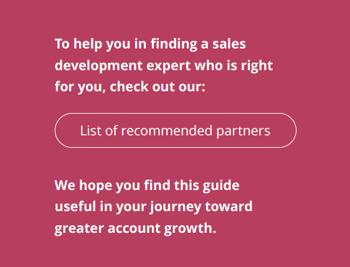
As a profession, sales is not great at account planning. Before we can effectively transform account planning and convert it into growth, we need to understand what we’re getting wrong and fix it. In working with b2b sales organizations of all sizes and across industries, we see three common account planning mistakes show up again and again:
1. Thinking “inside-out” instead of taking the customer’s perspective and connecting the dots
2. Placing too much effort on planning and not enough on making the plans come to life
3. Spending equal time on all your accounts
Chapter 1
Traditionally, account planning begins with an assessment of where a sales team might win “more wallet share,” where the “white space” is in an account, or how many additional products the team can sell into each account.
It then proceeds to analyzing how best to approach the client with this goal in mind. The question is: How can we sell more to this client?
This is the wrong question. We call this approach “inside-out” planning. It begins inside your company and looks “outward” at the client. It treats the customer like they’re a bank account from which you can draw funds. It fails to honor the fact that they have their own viewpoint on the relationship - and that viewpoint is more important to them than yours.
Instead, we recommend an “outside-in” approach, that starts from outside your company, with the customer’s perspective. An “outside-in” approach means choosing not to do some of the things you usually do. Specifically, don’t begin with what you want - begin with what the customer wants.
An outside-in planning approach asks questions that begin and end with the value that the customer perceives and needs from us. It includes questions such as:
Have we delivered on our past promises?
How and where is this customer getting the most from us?
Are there ways that we’re letting this customer down?
How do they perceive us (aligned with how we’d like to be perceived?)
What is their entire industry struggling with?
Are they struggling with the same issues?
What are their major initiatives?
How can we most effectively align with these initiatives? How do we connect the dots?
Who’s who and do we have the right relationships?
Do we have a clear and mutual plan of what to do together?
Could we be doing more for them?
How do we get it done? Who does what?
This approach requires sales teams to get to know their customers better. To ask probing questions and to take the customer’s perspective during, after, and before calls.
Outside-in planning is critical to the “understand” portion of the framework.

Chapter 2
Traditionally, account planning begins with the idea of capturing a lot of information about our accounts. Advanced spreadsheets called “Account Plans” are created and salespeople are tasked with filling these out.
More often than not, that’s where it ends. Stellar salespeople may take this structured information and execute on it, but average salespeople will struggle to go from data to execution.
On more than one occasion, our teams have had conversations with sales operations and sales enablement at major companies who want better account planning tools. They talk about how their teams need to plan better. But when we ask them, “Great, but what are they going to do with the plans?” they look at us blankly.
Account planning is a big topic, and frequently discussed. But too often, planning stops at the planning stage. It becomes an end in itself.
This is like making a map but not providing a route. If you’re trying to get from here to, for instance, New York City, a map can be useful if you’re good at reading maps, creating routes, and executing on the route. But the map is not the route itself. That’s why modern GPS systems provide routes and step-by-step instructions.
Not every salesperson is equally skilled at “reading the map” and creating a route. In order to get consistent account growth performance out of salespeople, teams need to create the map and a route, and break it down to step by step instructions to get there.
Currently, there are very few tools on the market that allow you to create the map, set the route, and create step-by-step instructions. But this is what sales leaders must look for when analyzing tools and methodologies to grow with their best customers.
Creating a route and a step by step account growth process that can be executed by salespeople is covered more fully in the “Grow” section of this paper.
Chapter 3
Some customers are more important than others. Yet many account managers spend equal amounts of time on all of them, or they prioritize according to an inner idea of what’s important, or according to whatever is in front of them today.
The “equal time” approach leaves salespeople feeling overwhelmed, and it leaves key accounts underserved. And the “gut feel” approach to prioritizing has just as many drawbacks. Cognitive bias and personal preference can lead salespeople to spend time with the accounts that are already spending a lot of money (but perhaps don’t have room for growth or aren’t invested in you as a strategic partner), or those who are friendly and warm (but perhaps don’t have a lot of budget), or those they have historically interacted with the most.
Unsupportive core beliefs can cause even more errors. Salespeople who have an inner need to be liked may focus on accounts where they have a personal rapport, regardless of the value of the account. Those who have an inner need to feel important based on name recognition may focus on accounts with big brand names that have little room for growth. Meanwhile, those whose inner beliefs include the idea that they aren’t qualified to speak to CEOs may focus on accounts where they can talk to mid-level employees and avoid hard conversations.
Leaving account prioritization to the salesperson’s gut is an expensive gamble.
Instead, organizations need to spend time segmenting their customers, and sales professionals need to spend time analyzing which customers have the most potential to grow with them. And all of this has to be done from the customer’s perspective.
That means that your teams need to begin spending more time with your most profitable accounts, asking them probing questions. What is their level of commitment to certain types of initiatives? Are they an innovative or conservative company? What is their attitude toward your team and the initiatives you help them with? What kinds of content do they eagerly consume?
Use these questions to drill down and identify criteria that help define your best customers, and then use those criteria to analyze other customers. With this analysis, you can then also segment your accounts to assign the right salespeople who have the best potential to grow the accounts.
Once criteria are established, they can be built into the process so that salespeople and their managers can see at a glance which accounts require the most attention and focus. Membrain’s account growth module provides this as a visual that is available on a rolling basis so you can always see which accounts need attention today.

RESEARCH REVEALS: GREAT CUSTOMER SERVICE HAS NO IMPACT ON ACCOUNT GROWTH
Great customer service is important to retaining customers. In a survey by Gartner, 750 sales organizations were asked to uncover the factors that drive growth within existing accounts. They found that product and service success improves retention by more than 100%.
However, the same study found that there is no correlation between product and service success and account growth.
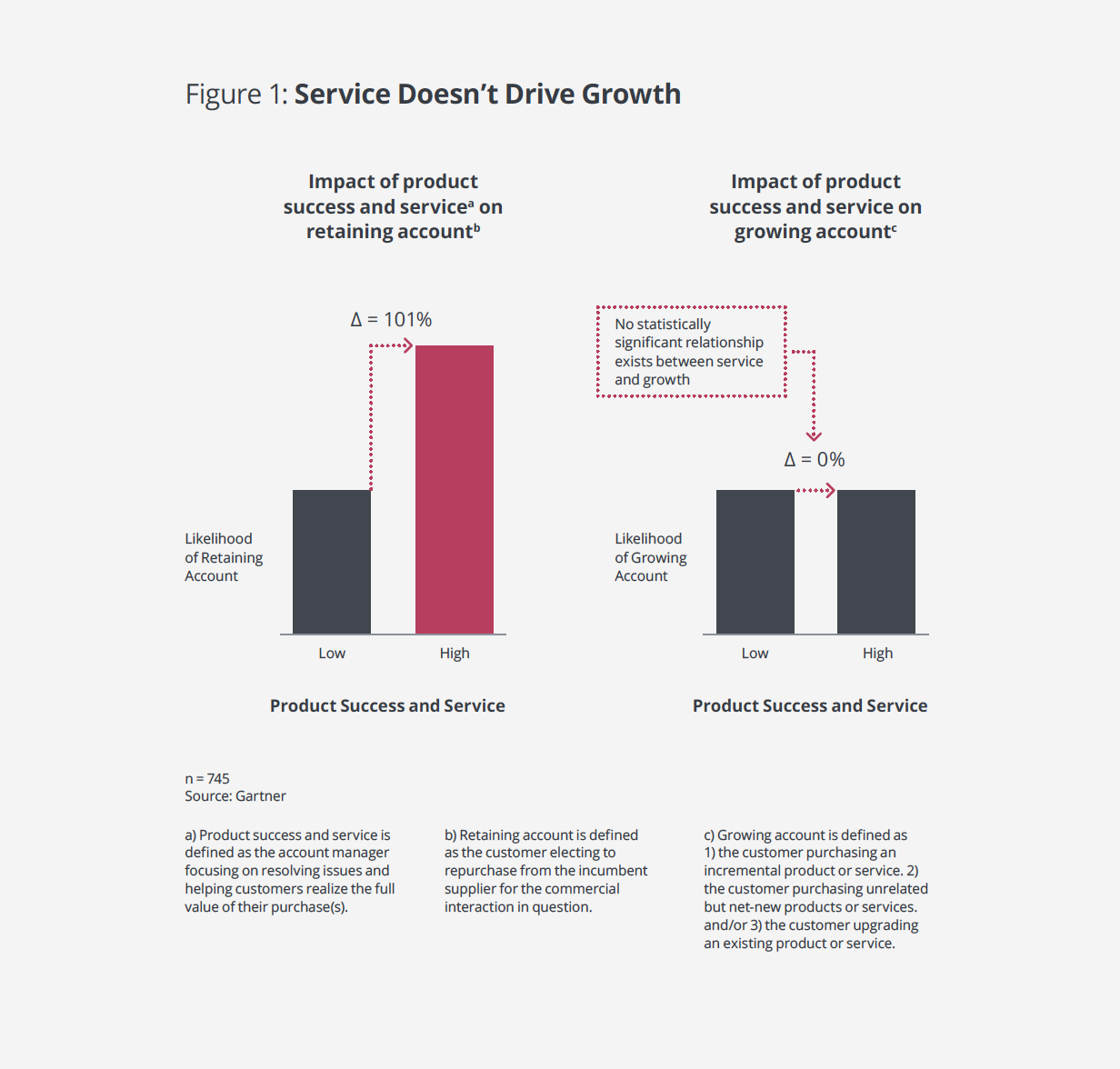
It is common to hear account management teams say things like, “We make our customers happy, and then they want to buy more from us.” Often, this means that is the only thing they are doing to try to grow the account. Unfortunately, this approach leaves a lot of growth potential untapped.
”There is no correlation between product and service success and account growth.”
Within the world of complex b2b sales, getting account planning right can be the difference between mediocre results and outstanding performance. While there are many ways to perform account planning, what most leaders need is a simple, proven, structured approach that can be applied across their organization and across markets.
At Membrain, we use a focus-align-grow-optimize framework that is flexible and executable in almost any complex b2b environment. The focus-align-grow-optimize framework provides structure for:
1. FOCUS
It’s easy and common for sales teams to waste time on accounts with very little potential for growth.
2. ALIGNING
Your plans and actions by doing your research about each key customer and meeting their needs to help them grow, and you with them.
3. EXECUTING
On your plan and process to drive the desired growth.
4. OPTIMIZING
The system by analyzing your relationships and the business outcomes to continually improve results.
Chapter 1
It’s easy and common for sales teams to waste time on accounts with very little potential for growth. There are countless reasons for this:
Salespeople spending time with clients they like rather than those most likely to grow
Salespeople thinking they need to spend time with everyone and becoming overwhelmed
Salespeople simply not knowing who to spend time with
In the “focus” portion of the focus-align-grow-optimize framework, sales leaders create simple formulas and processes for salespeople to identify high-potential accounts, so that they can focus on them.
Some organizations may spend substantial time on segmentation, bringing in partners and consultants to assist in defining ideal growth candidates.In other organizations, it may be enough to simply begin with a few key criteria and grow from there.
In Membrain’s account growth module, we make the focus aspect of the framework visual and impactful.
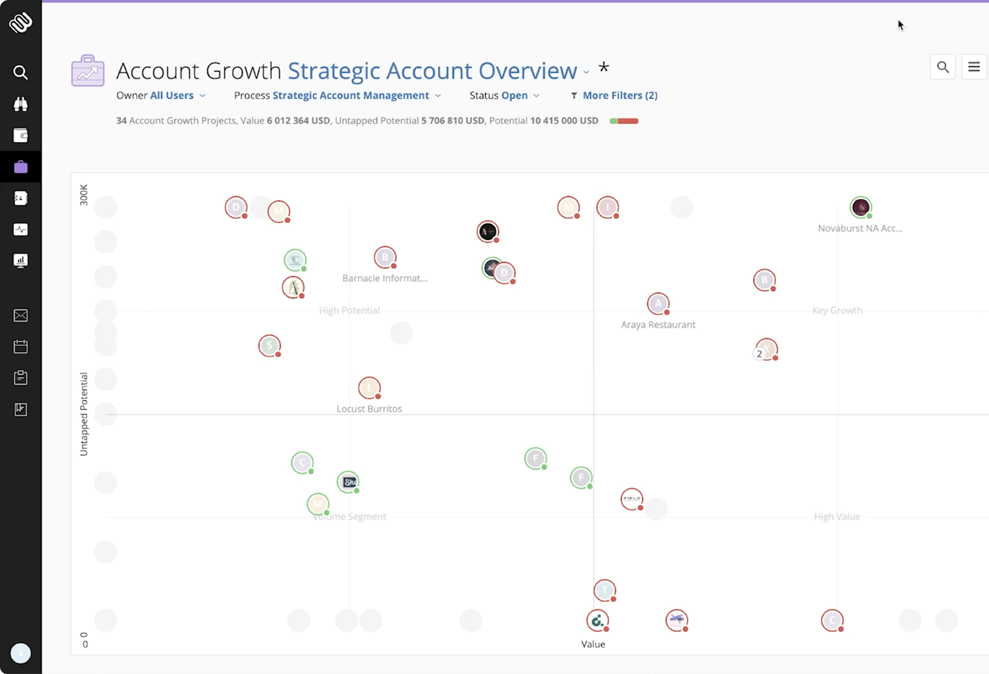
At a glance, salespeople can see immediately which accounts have the highest potential for growth, based on both their value and their untapped potential. The grid is based on criteria set by the team’s leadership and can be easily updated to account for new information about what makes an account more or less valuable.
As part of the focus conversation, it’s also important for sales leaders to understand how the customer values their sales team. Imagine the grid above but from the customer’s viewpoint. If your team is contributing value to them, you should fall somewhere in the upper quadrant. If you’re not seen as a valuable partner, you may fall further down and to the left.
Customers who highly value your team’s contributions are much more likely to continue to grow and buy more from you. On the inverse, even a customer with a budget and need to purchase more from you is less likely to do so if they perceive your sales team as bringing very little value.
Thinking about the customer’s point of view during the “focus” portion of the framework can help you both create better criteria for focusing, as well as find ways to improve your team’s value in the customer’s eyes.
Chapter 2
Once your team knows where to focus, the next step in the framework is understanding the customer in order to align with them.
How valuable are we to the client?
In the focus portion of the framework, we prioritize customers according to their value to us and our ability to grow with them. In the understand and align portion, we begin by focusing on the customer.
Net Promoter Scores (NPS) can be a useful tool at this point, but they do not go far enough. Harvey Dunham, Managing Director at the Strategic Account Management Association, says that an NPS is a little like going to the doctor and getting a blood panel and knowing that all of your scores are “average.”
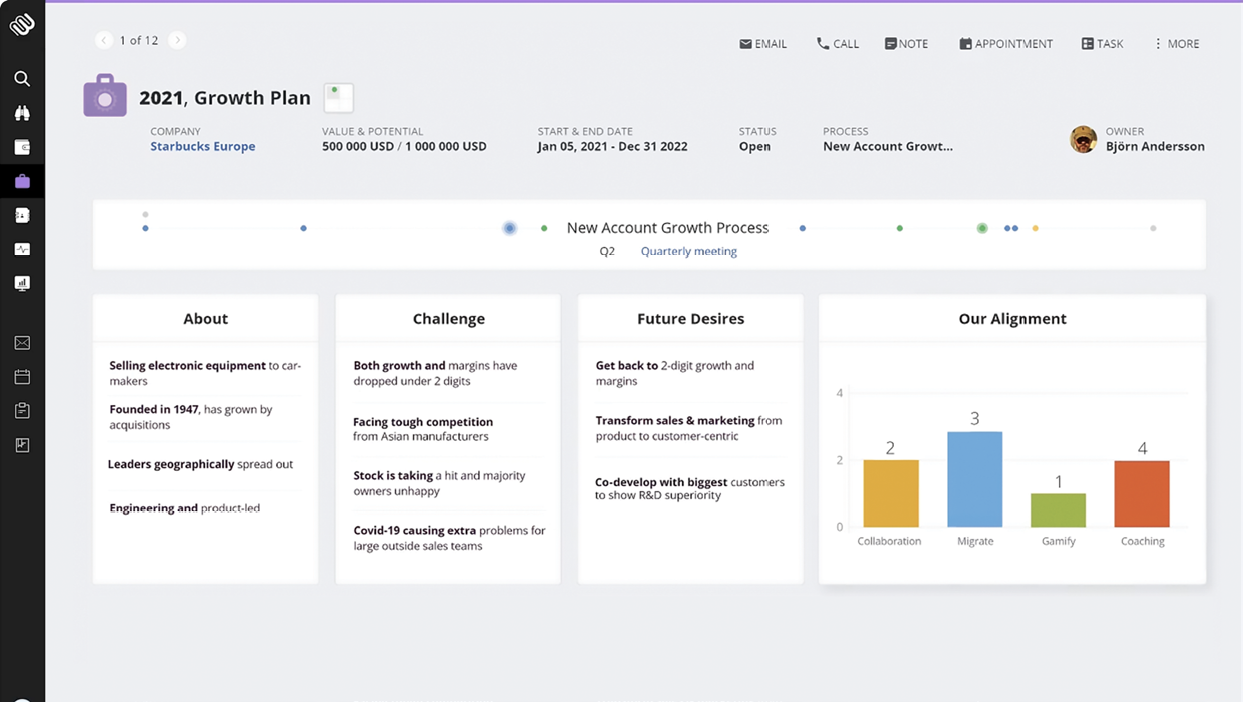
That’s good news, of course, but it doesn’t tell you anything about your health other than that it’s acceptable. Within the range of “normal” scores, some numbers will be closer to ideal, while others will be closer to a troubling range. Studying the numbers themselves can tell you a story about your health that might lead to changes to improve your health.
Likewise, a Net Promoter Score only tells you whether you are performing well with a customer, and not how or in what ways. It gives you no insight that can be used to better understand and align with the customer.
Dunham recommends implementing a regular program of interviews with high-value clients. These interviews should ask probing questions to find out not only that you are doing well, but the areas in which you particularly excel, as well as the areas where you are closer to average or even below average.
”Forget about your stuff, for a little while. Forget about your product and all the wonderful things it does. Instead, find out where the customer is trying to go with their business, and how you can help them get there.”
Such interviews can also be used to find out more about the value that your team provides to theirs, and where they perceive you on Dunham’s value pyramid:
✔️ TRANSACTIONAL
If your team is perceived as transactional, customers can be very happy with you and still not value you highly. A transactional vendor is one that can easily be replaced with another without much thought.
✔️ LARGE ACCOUNT
These accounts may be purchasing large quantities from you and may be perfectly happy with your price and delivery, but they have no loyalty beyond what you are doing for them right now. They may not easily switch between vendors, because they are accustomed to placing such large orders regularly but provided with enough incentive, they will switch without much thought.
✔️ KEY ACCOUNT
A key account is similar to a large account, except that you are on a preferred vendor list. This means that as long as you jump through their hoops and continue to provide good products and services, they will continue to purchase from you. They are unlikely to come to you for advice or to care what other lines of service you might have to offer.
✔️ SOLUTION PROVIDER
In this case, you are providing bundled solutions and services that help the customer company become better. They rely on you to bring a package that provides them with value. In order to be a solution provider, they have to trust you and you have to help them mitigate risk. When you are a solution provider, they will not usually jump ship to another provider unless someone convinces them to.
✔️ STRATEGIC PARTNER
When you are viewed by the customer as a strategic partner, they rely on you as an integral part of providing their product or solution to their customers. They come to your team for advice, insights, and bundled solutions that help them achieve their overall strategic vision. You are a trusted advisor, and they will not leave you except under extreme circumstances.

What actually matters to the client?
In addition to your value to the client, your account growth team needs to understand what matters to the client.
Clients themselves don’t always know exactly what matters most to them, so you can’t stop at simply asking them.
Research, data, probing questions, relationships, and collaboration are all important to get at the root of what truly drives your customers.
“You have to ask more questions, beyond just what they say on the surface,” says Dunham. “Keep pushing to get more, and sometimes it will open up a whole new world of possibilities. Now the customer may say, ‘Ah, I was going to pigeon-hole you, but now I see how much more you can do for us.’”
Think strategically beyond the next sale or making the day’s quota with this customer, and help them do the same. How is their industry changing? What will be happening for them in the next one, five, ten years?
Build relationships across the organization and find out from every stakeholder what’s most important to them, and make sure you can record all of it.
Tools inside Membrain’s account growth module make it easy for sales teams to access and record information about stakeholders and what’s most important to each one.
How do we align with the client team?
Understanding the client means understanding what matters to them, how they value you, and how their team works.
With that understanding, the next step is to consider how best to align your team to assist theirs. Line up your stakeholders with theirs so that the people with the best resources and tools to help are available to the people who most need those resources and tools within their organization.
In complex b2b sales, selling is rarely one-to-one, so don’t treat it like it should be. Each salesperson is part of a larger sales team that is all working toward the same outcome. And each sales team member must be aligned with the individuals within the client organization who most need their expertise and support.
Just as importantly, your team must orchestrate hand-offs so that the customer is never left hanging. This is most easily done with a CRM that supports assigning tasks and coordinating hand-offs and collaboration.
Remember throughout the process not to get stuck in inside-out research and planning, where you focus primarily on your own organization and your needs. Instead, engage and involve the customer, listen to them, learn and understand them. Expand your stakeholder reach and relationships within the client organization, and record this progress and the insights that come out of it.
How do we measure engagement over time?
With the switch from an “account management” mindset to an “account growth” mindset, it’s easy to see how important it is to understand HOW the account is growing over time.
A clear view of the account’s growth can not only show your team what they’re doing well, but also show them what they could be doing better, and where to focus for the best results.
It’s important to be able to see how an account has done historically, as well as how they’ve changed over time, to get a sense of the current health and potential.
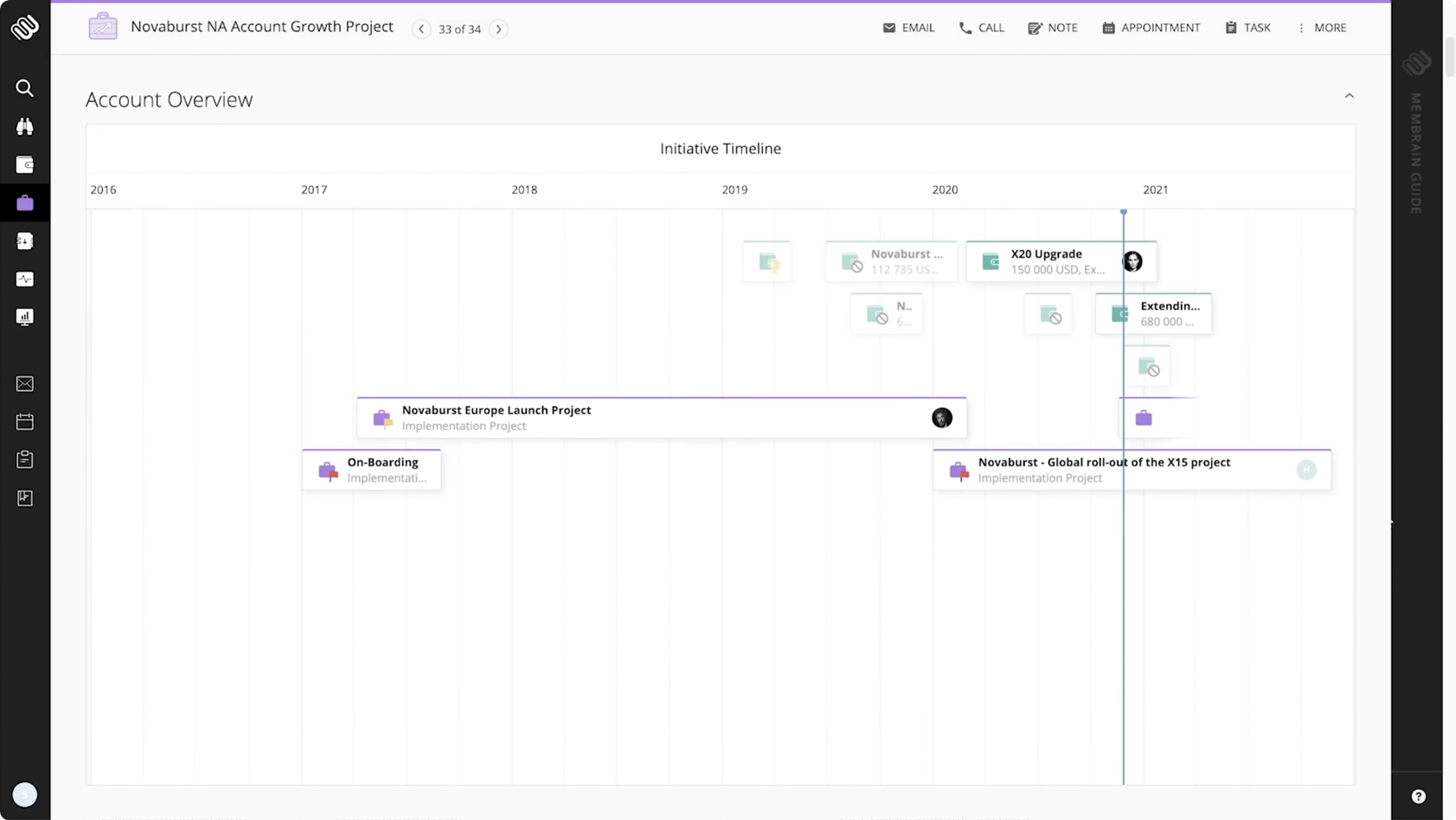
In Membrain, we handle this by providing a timeline view that provides an overview of the past, current, and projected future growth for each account. In it, you can see past projects, when they began, their success, and their completion. You can also see what is currently in process, and what has been planned for the future.
Chapter 3
A plan without action is just a dusty binder on a shelf. In the “grow” portion of account planning, you set in place the system for executing the plan so that you can make account growth actionable.
To do this, you need five key things:
During the alignment stage, you have come to understand your customer more deeply. You’ve identified how you can better align your team and your process with their needs.
In order to make this actionable, you need a formal process with stages, milestones, and steps. We often think of these in the context of managing a pipeline, but they are just as important in managing and growing accounts.
Stages may be as simple as “focus” stage (i.e., identifying where to spend time), “align” (as above), and “grow” (execution), exactly as outlined in this paper.
But within each stage are any number of milestones to indicate how well the account is growing and moving within that stage. For instance, within the “align” stage there may be a milestone such as “all key stakeholders contacted and aligned with our team.”
Steps are the actions that each team member takes to achieve a milestone. For instance, researching relevant stakeholders, assigning contacts to team members, etc.
This process should be formalized and placed directly into the sales team’s workflow. Ideally, this should be done within the CRM, where the salespeople already spend most of their time. Unfortunately, that can be hard to do.
At Membrain, we addressed this problem by creating the tools. In our account growth module, we provide the ability to set stages, milestones, and steps. To assign tasks and collaborate on them. And to visualize where each account is in the growth cycle.
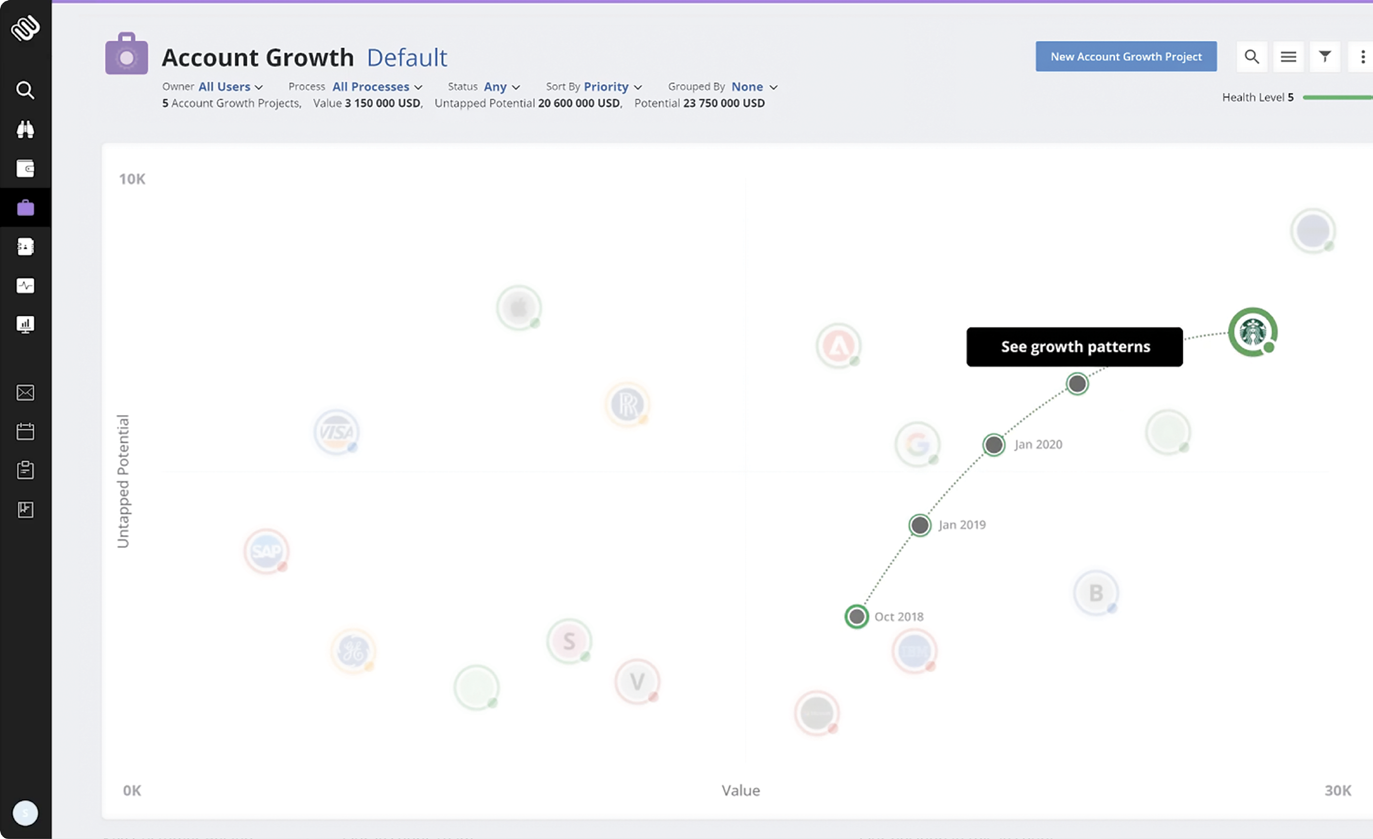
”There’s been a lack of tools for this in the account growth space, it’s starving for tools to visualize, aggregate, and collaborate at the account level - nobody thought about that when they built the CRM.”
The process is the stages, milestones, steps, and activities you take to grow an account. The methodology is the theory and approach behind HOW you approach those steps and activities.
It isn’t necessary to use an established or named methodology, although they can be very helpful. Regardless of whether you choose a packaged methodology or not, it is important that your team have a shared culture and understanding around how they approach customers and how they move them through the process.
This, too, should be embedded in their workflow along with training materials and collateral.
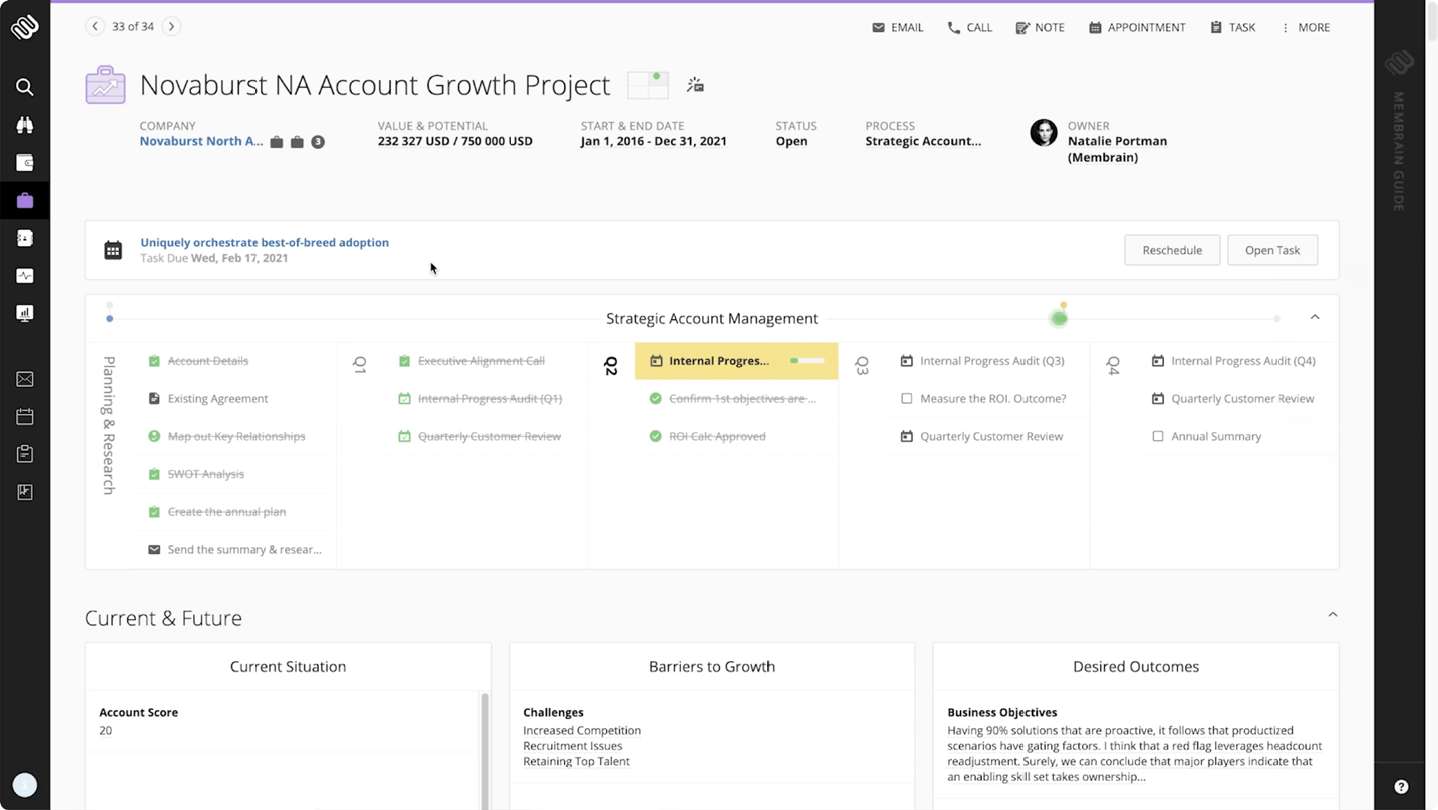
Furthermore, checklists free the mind from having to remember every routine detail, so that team members can focus on creative and responsive communication and collaboration.
And winning deals.
In his book, The Checklist Manifesto, Atul Gawande demonstrates how the simple addition of checklists improves the performance of highly trained professionals, including pilots and surgeons.
Checklists are a critical tool in reinforcing processes and methodology. They perform two key functions:
Even highly trained professionals make mistakes. Doctor-induced accidents are a leading cause of death in hospitals. Using checklists, and holding medical professionals accountable to them, reducing these accidents by 47%.
Likewise, salespeople and other sales team members make mistakes. It’s human. Checklists, help prevent “little” things from slipping and taking deals down with them.
Executing on process and methodology takes more than just reminders. Your people need to know HOW to do the things you’ve laid out for them to do, and how to do them right.
You could send them to off-site training and hope things stick. Or you can embed the training they need directly into their workflow, where it WILL stick.
The human brain learns better when it can immediately apply the training to situations that matter. Embedded training provides learning within the context to which it applies, thus making it “stickier.”
Account growth is a team effort. When you’ve gone to the trouble to understand the customer and align your team with them, you don’t want to fumble when it’s time to pass the baton.
Within Membrain, we handle collaboration by providing the tools you need not only to communicate, but also to hold each other accountable and hand off tasks at the right times and in the right order.
You can assign tasks, and receive notifications when they are complete. You can create and view organizational charts that help you visualize who is involved and how you are aligned with the customer team. And you can have conversations directly within the workflow that are easy to track and review.
Coaches can embed coaching content and easily see where salespeople are in growing the account. And the timeline view helps everyone on the team see where the project is.
Another benefit is that you can embed 3rd party tools inside of account growth projects, like white-boarding tools such as miro.com, which can further simplify team collaboration.
Imagine a salesperson preparing to call a newly identified stakeholder for the first time. They’re feeling a little nervous because they’re going to be using new skills and asking questions they’re not used to asking. As they prepare for the call, they click on a video within their CRM that demonstrates the best way to ask the questions and present the conversation.
After watching a three-minute refresher, they feel more confident and more firmly remember the right way to do it.
That’s the power of embedded learning.
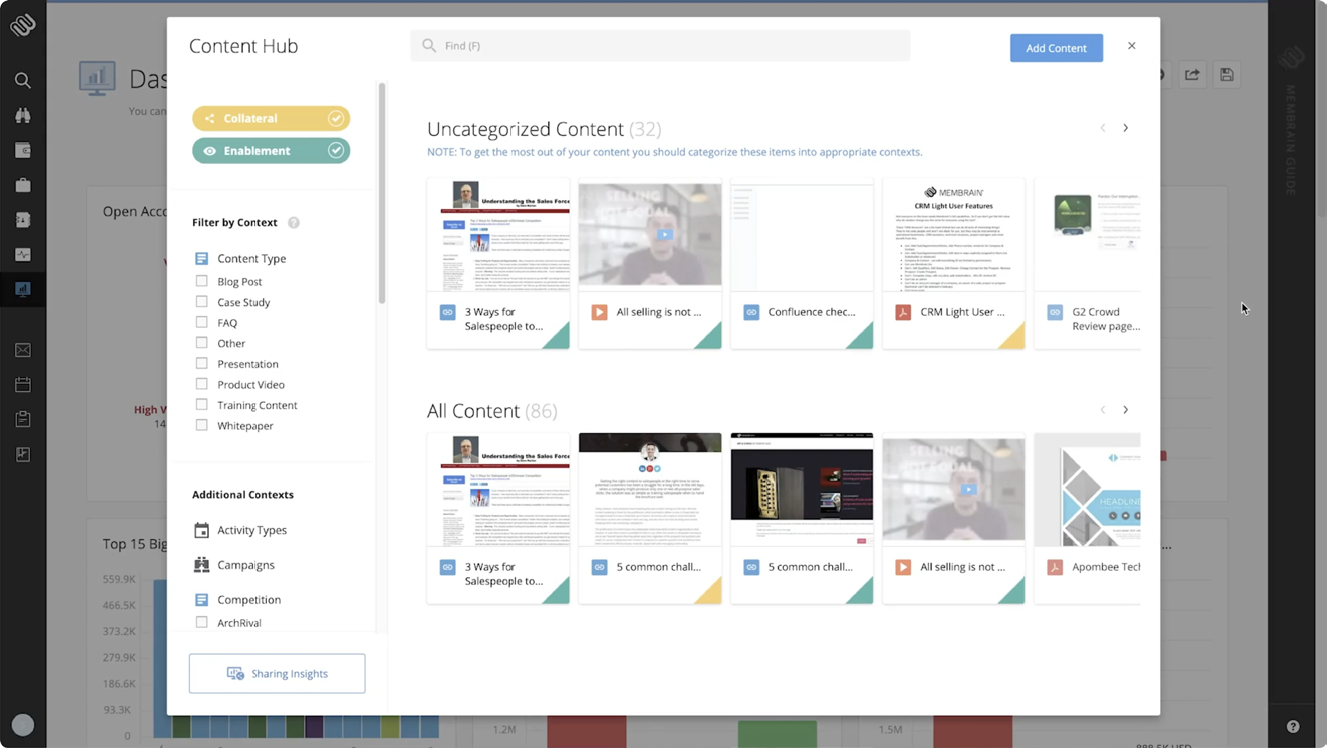
Embedded training means that salespeople can revisit training as often as they need it until it’s firmly established as a habit.
Chapter 4
In the “dusty book on a shelf” approach to strategy, planning becomes a “once and done” activity that never gets any better (and usually isn’t even applied).
In a true account growth approach, constant improvement is baked into the process.
Planning is never over. It is constantly updated and made better based on feedback and results.
In order to achieve constant improvement, leaders need data and analytics that enable them to see what is working, what’s not working, and what could be working better.
They need to see what content customers are engaging with, what steps in the process move them forward more consistently, which salespeople are executing most effectively, and what aspects of the process don’t move the needle.
Then they need the ability to coach salespeople in what matters and hold them accountable to the right activities, behaviors, and process improvements.
They also need the ability to change the process, training materials, and content within the CRM to reflect improvements and adjustments in the account growth process.
Typically, these aspects of account planning, if they happen at all, involve a lot of manual updating and/or expensive development time to embed the changes.
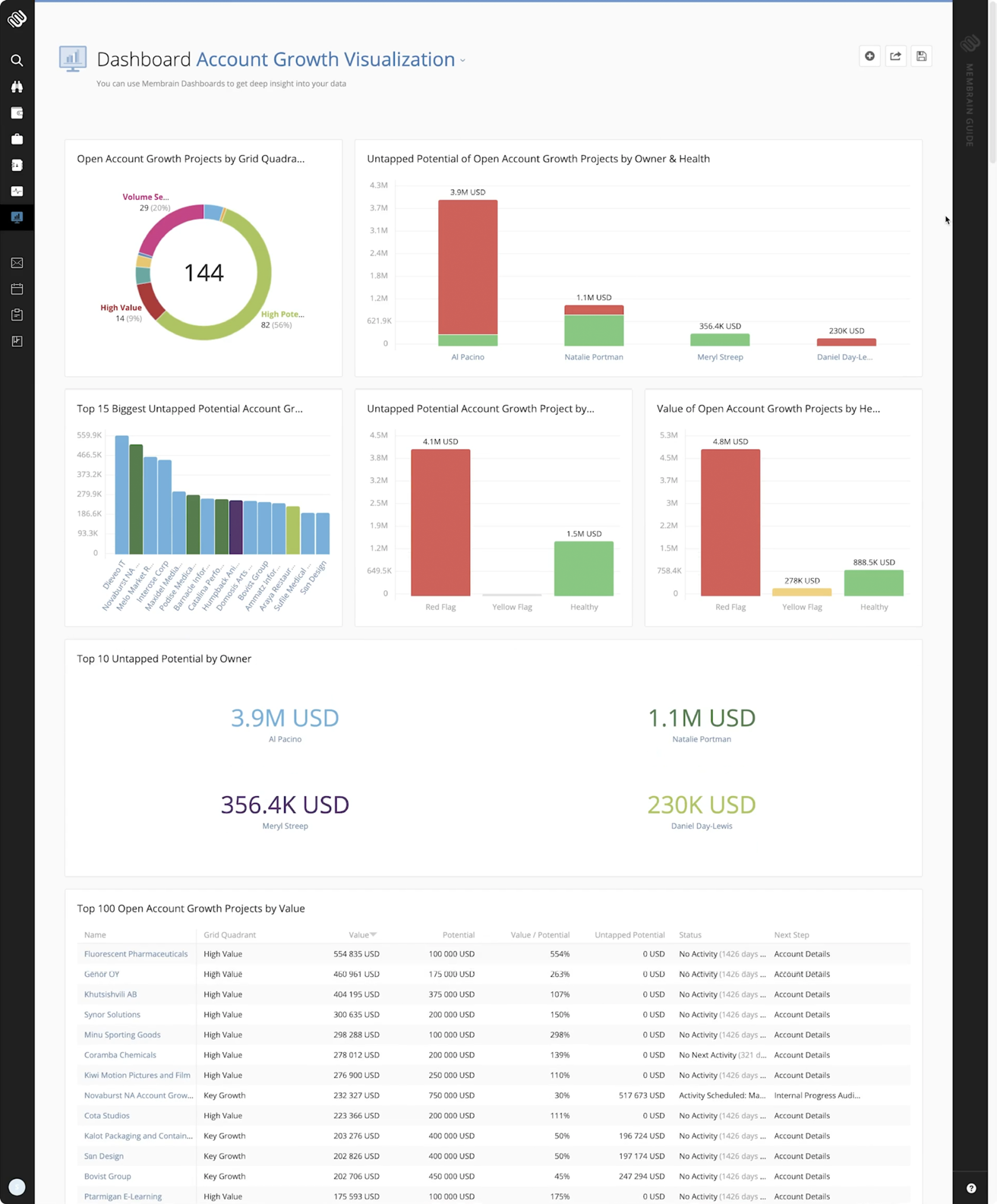
In Membrain, we solve this problem by making the analytics easy and effective, and making it easy to change the process workflow to immediately reflect updates.
Additionally, it’s easy to create custom dashboards, set goals, and implement surveys to find out how well you’re doing from both the customer’s and the sales team’s perspectives. We believe these are the best tools on the market for the job, but regardless of what tools you use, constant improvement must be baked in.
Implementing effective account growth planning can transform sales results. But the benefits don’t end there.
The same skills and tools that support good account growth planning can also be used to improve:
✔️ CUSTOMER SUCCESS
Customer success teams can use the account growth framework to get in close with customers and provide them with the support they need to make the most of your products and services. The same process of focusing, aligning, and growing works for your success teams as well, as do the process, methodology, checklists, embedded learning, collaboration, and constant improvement tools.
✔️ PARTNER MANAGEMENT
Many companies grow through their partners. At Membrain, for instance, we have a committed network of partners who are trainers, consultants, and sales professionals who believe in our product and use it to execute with their clients.
The account growth module in Membrain is an effective management tool for staying in touch and managing relationships with partners. Just as it works with customers, it helps your teams focus on the partners who can best grow with you, understand them, align with them, and grow with them.
Changing your mindset to think beyond account planning and into account growth can be transformational for your complex b2b sales teams. We believe the steps and tools outlined in this paper provide the most actionable and flexible framework for account growth available.
With this framework in hand, you can become a trusted advisor to your highest value customers and make yourself indispensable. Your customers will grow, and you will grow with them.
We hope that this has been helpful to you. If you would like to know more about the tools we use to implement this framework, please check out this page and let us know if we can help you.
Know Your Customers. Grow Your Customers.
From north to south, east to west, Membrain has thousands of happy clients all over the world.



